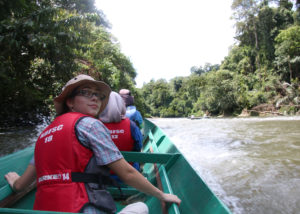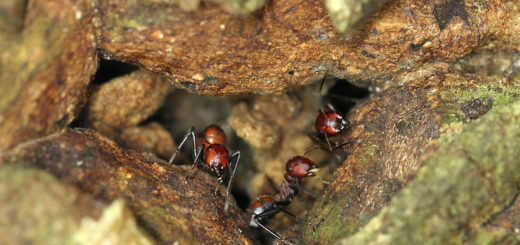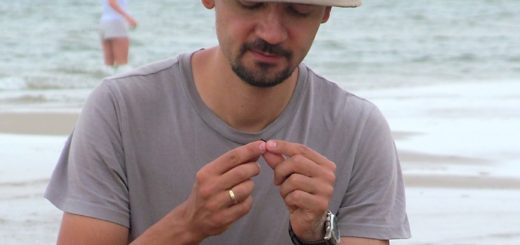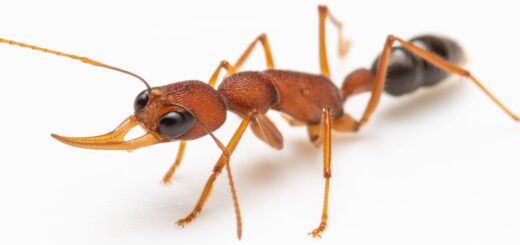Interview with Brian L. Fisher

Brian L. Fisher in Uganda. © Alex Wild
Brian Lee Fisher is an American myrmecologist with a particular focus on ant biodiversity and systematics. He has mainly conducted fieldwork in Africa and Madagascar and worked for almost five years at the South African Museum in Cape Town. Since 2000, he has been a curator at the Department of Entomology at the California Academy of Sciences. He is also well known as the founder of AntWeb, a comprehensive online database of ant images and specimens records. In this interview, we talk about his work and his career.
An Interview compiled by Alice Laciny 
MNB: Thank you for talking to us about yourself and your career as a scientist. You lived in South Africa, right? What was it like to live there?
BLF: Yes, it was wonderful, with Africa as your backyard; a short flight to Madagascar, no jetlag; I could be in the Congo Basin by lunchtime, it was ideal!
MNB: Sounds awesome! And that leads us right into our questions – Could you please summarize the main topics of your current research for us? I heard you just got back from Madagascar, so maybe tell us a little bit about that.
BLF: I’ve been focused on understanding ant diversity and how it changes across landscapes. Now, this is quite common in biology – if you are a botanist, you understand and document how vegetation changes – but it’s actually quite challenging to do that in ants. You just have to do one inventory in the tropics to realize how challenging it is. Initially, you have to figure out how to inventory the ants. Now, we have made lots of progress on that. In fact, my PhD was to develop the leaf-litter sifting method (mini-Winkler) as a tool for documenting ant communities and assemblages that live in the leaf-litter, especially in the tropics. But then, once you do a second inventory, you have to compare species between those two sites. Determining species boundaries becomes harder and harder the more sites you visit. At one site, it’s usually quite easy to tell species apart. But as soon as you increase geographic distance, things become harder. And I think it’s especially hard in a place like Madagascar, where you have high levels of micro-endemism turnover.
MNB: Very exciting! And is that what you are currently looking at?
BLF: I’ve been looking at that my entire career, in a sense. But to be successful, you have to do a lot of background work. First, you have to build up an inventory, and then you have to process specimens at a large scale. To do that, I’ve developed these labs, first in South Africa, then in Madagascar, where I have a team of people to help me process large-scale sampling of thousands of specimens a year. And secondly, you have to learn how to identify the resulting specimens. That means you have to do a lot of basic taxonomy. The genetic tools we have available now have changed how we do this research.
MNB: So, if that’s what you have been doing for the past years, how did you start getting into myrmecology? What was your initial inspiration?
BLF: Well, at first I thought I wanted to be a botanist. I went to the tropics, to Panama, to live on an island called Barro Colorado Island, with the Smithsonian. I stayed there for a year as an undergraduate, which was quite lucky. And as I explored Panama, I collected plants, and the local botanist there could actually tell me what species of plant I had collected. And on these plants, I was collecting ants, and I kept asking questions about the ants, but nobody could tell me anything. So I had to write people. I wrote to Bill Brown at Cornell (University) and to Roy Snelling at LACM (Los Angeles County Museum of Natural History), and this correspondence was the only source of information. I wondered how in the world could there be so little knowledge available about such an obviously dominant group, especially in the tropics? So I decided to switch from studying plants, to ants. In fact, my first papers were on plants, then I started studying plant-ant interactions, then shifted 100 percent to studying ants. So when I went to graduate school, on paper, I was more of a botanist than an entomologist.
MNB: That’s quite a journey! And what would be your motivation for doing myrmecological research now?
BLF: To be honest, my motivation is discovery. And how we can discover has changed with technology. Before going to Madagascar for the first time, I was focused on finding what genera were in Madagascar. I was lucky that very little was known about the ants anywhere in the entire country. Finding what genera lived in the leaf litter from that first leaf-litter sample was so exciting! At that time, I simply used the existing keys to genera to identify what I was collecting. And to be honest, I was tricked. A few of the genera were actually new, but were hidden in the existing, convergently similar genera. I fell into the trap of assuming things were known; so it was easy to say “that keys out to this genus, so it must be this genus,” without realizing that in a place like Madagascar, the assumption should be that it’s different, and you should figure out what it is by careful study. The careful study of morphology is always time-consuming and very difficult. Having males would have made it evident that they were not the same genus. But at that time, we often didn’t have males to include for comparison. Now we have molecular data. This is what makes going back to the field even more exciting. We are almost to the point where we can create a backbone species-level or species-group level phylogeny of all ants, using next generation sequencing advances such as UCEs (ultraconserved elements). In fact, the most important global effort we should be making right now, as a collective community, is figuring out how to work together to make that species-level phylogeny. Then imagine, once in the field, you basically become a lineage hunter! To me, that’s the most important thing to understand in ants: their evolution. To understand evolution of ants as a whole requires uncovering rare lineages that often provide very important clues, just like the recent discoveries of Martialis. And they’re still out there. Molecular data will help us discover them.
MNB: That leads perfectly into our next question – what do you think is the biggest difference between myrmecology when you started out and the way it is now? From what you just told us about your research, it sounds like the addition of modern molecular methods and technology plays an important role, right?
BLF: Yes, that’s right! I can’t wait to see the phylogenetic tree after I get back from the field, to find out where these bizarre specimens sit. I think that each moment in science has its own tools available to make great progress. And right now, with tools like UCE techniques, we can actually document the major lineages of ants very clearly and figure out their relationships. That would take a big effort, but it’s doable in five years. And that tree would impact all fields of ant research going forward, from how we do taxonomy to understanding the social dimension of ants. We can build on that tree with studies of observation and behaviour, community assemblages … understanding the relationships is the backbone and the beginning of all the more interesting questions! Right now, we have a chance to actually work on that backbone, and that will stimulate and improve how we do many types of research on ants.
MNB: Yes, very good point. So, what do you think will be hot topics in ant research in the next ten years?
BLF: Ant research spans a diverse number of fields in science. All these areas of ant research will soon be able to ask questions with a backdrop of a global species level ant phylogeny.

During fieldwork in Madagascar. © Christian Peeters
MNB: And if you had to choose a different career than being a myrmecologist or entomologist, what else would you have liked to be?
BLF: I actually call myself a myrmecologist, because I work mainly on ants. The bottom line is, I love exploring. And insects provide an amazing opportunity to explore and discover. I really enjoy going to a new tropical rainforest, and finding new species … I would have found another group of unknown insects or arthropods.
MNB: That’s what I love about insects, too! And if you think about your life as a researcher, what was the biggest obstacle, the most difficult thing you had to do?
BLF: I think that ant diversity is too vast for one person to comprehend. That’s unfortunate, because you can never get a handle on an entire fauna. Even on Madagascar – I thought I could be done there in five years, but I’m still working there 25 years later. The level of diversity is just so huge, and each project you do takes such a long time. That’s one of the challenges of working in systematics and taxonomy – even the simple projects go on for so long. I started AntWeb in 2002 to try to put a face on every ant species. We have still only imaged about 75% of all species. Currently, we have teams in South Africa and in Kiev doing imaging. But clearly imaging needs to go on for another five years at least to get maybe 90% of the types imaged. Is imaging science? No, but so many aspects of being an entomologist are not classical science, which is generating data to test hypotheses. It’s also being a clerk and doing a lot of work that is immediately taken for granted, like Barry Bolton’s list of valid species (AntCat). Now we’re getting images of all those species. It’s the dedication to those projects that allows science as a whole to go forward. But it’s challenging because it takes forever.
MNB: Sure, there are just so many different ants! By the way, thanks for creating AntWeb, it is a true lifesaver! Can you think of any anecdotes from your work? Do you remember anything particularly scary, funny, or surprising?
BLF: I spend almost half my time getting to the field. So there are lots of stories full of incredible adventure. There have been times we’ve spent ten days in transit without ever actually getting to the field site because of a cyclone or other difficulties. For me, those trips often turn out to be some of the most memorable times I’ve spent on expeditions. I’ve had the pleasure of sharing those trips with people like Christian Peeters, who shares my enjoyment of suffering to find great ants in the field. Sharing discoveries with other people is a big part of what makes field biology so great. We have so many wonderful colleagues! And it’s also been great teaching students through the 17 Ant Courses we’ve held around the world! It’s always one of the highlights of my year to work with the other course instructors and students.
MNB: Very nice! And if you had to choose one ant, phenomenon, or morphological structure, what would be your one favourite thing about the world of myrmecology?
BLF: Mandibles! They are all so amazingly different.
MNB: Mandibles really are cool!
MNB: Is there any particular situation in which you typically have the crucial idea for solving a difficult problem?
BLF: Trekking through hillsides in Madagascar on the way to find a forest. There’s something about 12 hours of hiking that calms the mind. Eating cookies often helps, too, when I am in the office.
MNB: And what do you wish everybody knew about ants or one question you wish people would stop asking you?
BLF: Ha! I could give a talk on the wonders of the interesting natural history of ants, and as soon as I finish, the first question is always “How do I kill the ants in my bathroom or kitchen?”
MNB: A classic!
MNB: And if you try to answer that question, do you have any secret recipes to get rid of ants in your house?
BLF: We do have a citizen science project where we give out six different powders people often have in their homes (cinnamon, cloves, etc.) and people are testing those in their homes. We haven’t analysed the data yet, but maybe we will have suggestions on the best way to control – not kill – the ants soon. But I prefer the cookie crumb method suggested by E.O. Wilson. You just put crumbs on the counter and watch them. We have done everything to push nature away from us, and yet here it is coming into our lives. So just let it in, and watch it – you’ll be amazed to see them do their real behaviors right in front of you!
MNB: I like that method! So, if someone is a complete myrmecology newbie, maybe just starting their Master’s or PhD project on ants, what’s your main suggestion to them?
BLF: Take Ant Course!
MNB: The higher the career level, the fewer women, also in ant research – what do you think will be most important for achieving gender equality in this respect?
BLF: Opportunity. Diversity in myrmecology will improve myrmecology. In Ant Course, we accept an equal number of women as men into the course – in part, because there are almost as many women applying as men – but as a community, we need to make sure all types of students are offered opportunities to succeed in the profession. It’s the responsibility of the community to help speed the change.
MNB: Does your group harbour students or postdocs with kids?
BLF: Yes, but having kids in San Francisco is not easy because of the high cost of housing.
MNB: And if you could push the restart button on your career, is there anything you would do differently now?
BLF: That’s an interesting question! One often tries to do science that has a larger impact. And I actually think one of the most important things I could be doing right now is this global phylogeny of ants. I am very focused on Madagascar right now, and maybe I should have had more of a broad focus. But I can’t think of one thing I would have done in a completely different way.
MNB: No regrets is good! Now for some quick either/or questions. Watching sports or doing sports?
BLF: Doing sports.
MNB: Listening to or making music?
BLF: Making music.
MNB: Evening or morning?
BLF: Morning.
MNB: Tea or coffee?
BLF: Coffee.
MNB: Sugar or sweetener?
BLF: Neither.
MNB: Cooking yourself or eating what someone else cooked?
BLF: Eating.
MNB: Habit or change?
BLF: Change.
MNB: Aspirator or forceps?
BLF: Aspirator!
MNB: Nest densities or pitfall traps?
BLF: Pitfall traps.
MNB: Field or lab?
BLF: Field.
MNB: Pin or ethanol?
BLF: Pin.
MNB: Paper reprint or pdf?
BLF: pdf.
MNB: Journals financed by the author (open access) or the reader (subscription)?
BLF: Open Access (gold if a taxonomic work, green – self-archiving, e.g., BioRxiv, is sufficient otherwise).
MNB: Kin selection or group selection?
BLF: Hmm … group.
MNB: Monodomy or supercoloniality?
BLF: Monodomy.
MNB: Worker or queen?
BLF: Worker.
MNB: What’s the book on your bedside table?
BLF: It’s a Kindle with loads of books! Right now, I’m reading “The Jungle of Stone”, about the Mayans.
MNB: Sounds interesting!
MNB: Your favourite ant?
BLF: Those in the XMMAS clade (Xymmer, Myopopone, Mystrium, Adetomyrma and Stigmatomma).
MNB: … and if in another life you were an ant, what ant would that be?
BLF: So many to choose from… maybe Ankylomyrma coronacantha, so that I can finally learn what it does for a living.
MNB: Thanks a lot for the interview, it was really nice talking to you!





Recent Comments